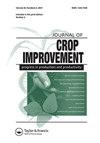Genotype by environment interaction analysis of grain yield and yield components in provitamin A maize
IF 1.5
Q3 AGRONOMY
引用次数: 4
Abstract
ABSTRACT Selecting superior genotypes for varietal release and commercial use is a key breeding objective. The use of appropriate statistical methods to analyze the complex genotype by environment interaction (GEI) phenomena may increase the efficiency in selecting superior genotypes. The objectives of this study were to evaluate the performance of maize (Zea mays L.) genotypes in diverse environments and identify and recommend high-yielding and stable genotypes for farmer adoption. Seven provitamin A maize varieties, including checks, were evaluated in 11 environments from 2016 to 2018. A linear mixed model analysis was performed using restricted maximum likelihood (REML) and the best linear unbiased prediction (BLUP) methods to estimate genotype, environment and genotype by environment interaction (GEI) variance components; and predict genetic values. Genetic correlations were also calculated to describe relationships across multiple environments. Genotype main effect plus genotype by environment interaction (GGE) biplot analysis was performed using BLUP estimates. The effects of genotype, and environment and GEI were significant (P< 0.05) for grain yield. Both the mixed model and the GGE biplot identified PVA SYN 21 (G2) as a superior genotype on the basis of its mean performance. The GGE biplot analysis revealed that this cultivar was also the most stable genotype across the 11 environments. The mixed model analysis allowed for an efficient selection of superior provitamin A maize genotypes.维生素A原玉米籽粒产量及产量成分的环境互作基因型分析
选择优良的基因型用于品种释放和商业利用是育种的关键目标。利用适当的统计方法对环境相互作用(GEI)现象进行复杂基因型分析,可以提高选择优良基因型的效率。本研究的目的是评价玉米(Zea mays L.)基因型在不同环境下的表现,并确定和推荐高产稳定的基因型供农民采用。包括检查在内的7个维生素A原玉米品种在2016年至2018年的11个环境中进行了评估。采用限制最大似然(REML)和最佳线性无偏预测(BLUP)方法进行线性混合模型分析,通过环境相互作用(GEI)方差分量估计基因型、环境和基因型;并预测遗传价值。还计算了遗传相关性来描述多种环境之间的关系。采用BLUP估计进行基因型主效应和环境相互作用(GGE)双图分析。基因型、环境和GEI对籽粒产量的影响显著(P< 0.05)。混合模型和GGE双图均根据PVA SYN 21 (G2)的平均性能确定其为优良基因型。GGE双图分析表明,该品种在11个环境中也是最稳定的基因型。混合模型分析可以有效地选择优质维生素A原玉米基因型。
本文章由计算机程序翻译,如有差异,请以英文原文为准。
求助全文
约1分钟内获得全文
求助全文
来源期刊

Journal of Crop Improvement
Multiple-
CiteScore
3.30
自引率
7.70%
发文量
42
期刊介绍:
Journal of Crop Science and Biotechnology (JCSB) is a peer-reviewed international journal published four times a year. JCSB publishes novel and advanced original research articles on topics related to the production science of field crops and resource plants, including cropping systems, sustainable agriculture, environmental change, post-harvest management, biodiversity, crop improvement, and recent advances in physiology and molecular biology. Also covered are related subjects in a wide range of sciences such as the ecological and physiological aspects of crop production and genetic, breeding, and biotechnological approaches for crop improvement.
 求助内容:
求助内容: 应助结果提醒方式:
应助结果提醒方式:


